#pauli murray
Text
Harriet said "Hold on"
Zora said "Kinfolk over skinfolk"
Pauli said "Hope is a song"
Fannie said "sick n' tired of bein sick n' tired"
Rosa said "Nah"
Audre said "Enuf"
Cori said "Fuck fascism"
#tag black women who paved the way#black lives matter#cori bush#angela davis#toni morrison#mary church Terrell#ida b. wells#fannie lou hamer#rosa parks#zora neale hurston#pauli murray#audre lorde#lorraine hansberry#lupita nyong'o#angela bassett#ava duvernay#audra mcdonald#our world#ecosystem of white supremacy#politics#history#padawan historian
872 notes
·
View notes
Text

Today We Honor Pauli Murray
At 30 years old, Pauli Murray was arrested for violating segregation laws in Virginia by sitting in the “whites-only” section of the bus. This incident, among others, sparked her passion for civil rights work.
She enrolled at Howard University’s law school and graduated at the top of her class. Despite her outstanding academic achievements, she was denied the opportunity to do post-graduate work at Harvard, which she believed was due to her gender and race. This didn’t deter her, though, and she graduated from Yale Law School in 1965. Murray later wrote the influential book, States’ Laws on Race and Color, which served as an encyclopedia of all the states’ laws concerning race.
In recognition of her pioneering work in gender discrimination, Ruth Bader Ginsburg named her as a coauthor in the Supreme Court Case Reed vs Reed.
CARTER™️ Magazine
#pauli murray#carter magazine#historyandhiphop365#wherehistoryandhiphopmeet#history#cartermagazine#today in history#staywoke#blackhistory#blackhistorymonth#carter
79 notes
·
View notes
Photo
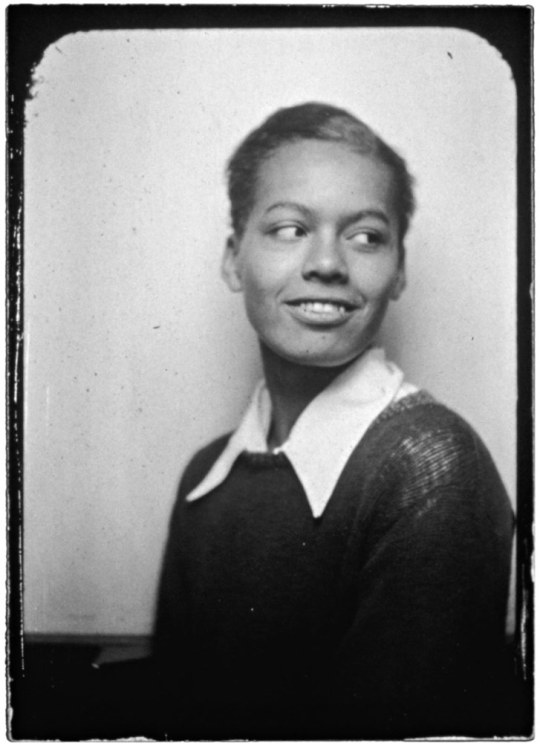
Black History Month: Pauli Murray
Pauli Murray was born in Baltimore, Maryland, in 1910. Growing up, he felt his gender was only understood by a few people, who, in his own words “accept me pretty much as one of nature’s experiments, a girl who should’ve been a boy, and react to me as if I were a boy”.
While studying law, Pauli pioneered a new strategy of fighting racial segregation through protesting its unconstitutionality, which would eventually be successfully used in the 1954 landmark civil rights case Brown v. Board of Education, which ruled the segregation of public schools unconstitutional.
After graduating as a lawyer, Pauli fought for civil rights and women’s rights, and wrote on the dual oppression expression by Black women. He also penned States’ Laws on Race and Color - a foot-thick book referred to as the Bible of civil rights legislators.
Pauli was a high achiever - as well as a lawyer, he was a poet and memoirst, and in 1977, became the first Black person assigned female at birth to be ordained as an Episcopalian priest.
Pauli passed away in 1985, aged 74. His groundbreaking legal theories and ideas about intersectionality remain as important today as they were over 50 years ago.
Learn more
[Image: portrait of a young Pauli Murray]
301 notes
·
View notes
Text
Pauli Murray
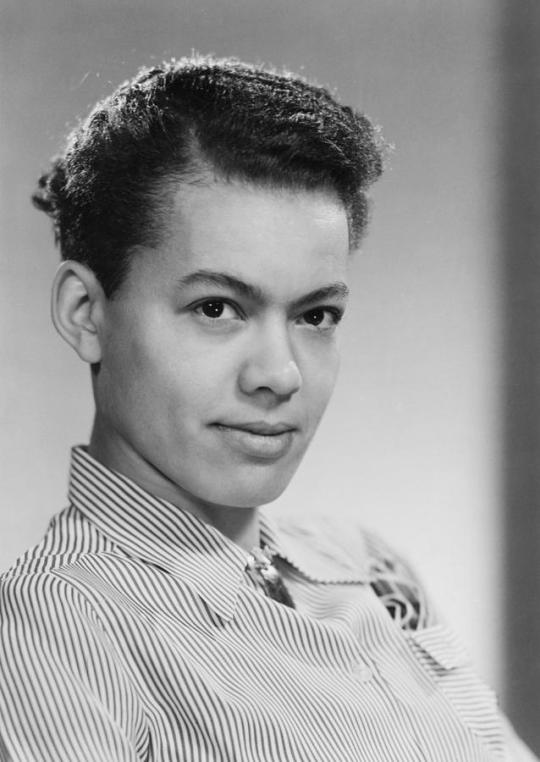
“I . . . feel that you are the sort of person who prefers to be accepted as a human being and not a human paragon”
-- Pauli Murray to Eleanor Roosevelt, December 6, 1938
Student activist Pauli Murray and Eleanor Roosevelt developed a close friendship that lasted over two decades. The two first met briefly in 1934, when ER visited a women’s CCC camp where Murray was enrolled. Four years later, Murray sent this letter to the First Lady—the start of an extended correspondence that would continue until ER’s death in 1962.
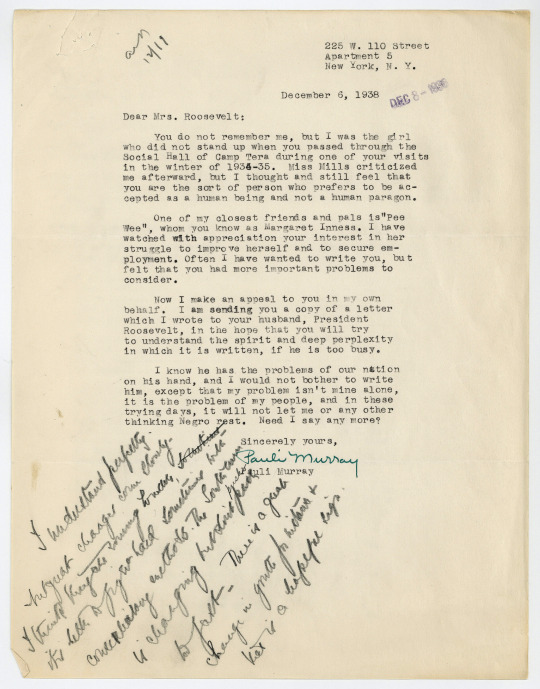
Murray enclosed a long letter she had sent to FDR “in the hope that you will try to understand the spirit and deep perplexity in which it is written, if he is too busy.”
Eleanor responded quickly to Murray. “I have read the copy of the letter you sent me,” she wrote, “and I understand perfectly, but great changes come slowly. I think they are coming, however, and sometimes it is better to fight hard with conciliatory methods. The South is changing, but don’t push too fast. There is a great change in youth, for instance, and that is a hopeful sign.”
Document: AR 2023.1.82/Franklin D. Roosevelt Presidential Library and Museum
Learn more about Pauli Murray in our current special exhibition BLACK AMERICANS, CIVIL RIGHTS, AND THE ROOSEVELTS, 1932-1962.
7 notes
·
View notes
Text
All of my icon-drawing, meme-making, and queer Christian history research has led to this moment:
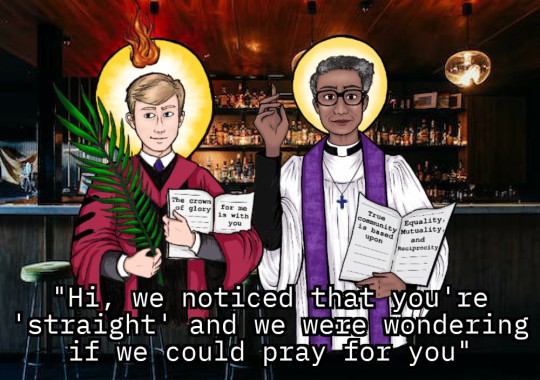
The unstoppable tag team of the Reverend Doctor Pauli Murray and Professor John Boswell, King and Queen of gender and sexuality, 20th century queer elders and patron saints of LGBTQ Christians, have destroyed the cisheteropatriarchy once and for all
(They've also seen our online queer discourse and they're not impressed)
17 notes
·
View notes
Text
17 notes
·
View notes
Text

Pauli Murray, November 20, 1910 / 2023
Image: from Pauli Murray, 1966-71 Dorothy Kenyon papers, Sophia Smith Collection, Smith College Special Collections, Northampton, MA (pdf here)
#manuscript#pauli murray#birthday anniversary#dorothy kenyon#dorothy kenyon papers#sophia smith collection#smith college special collections#1910s#1960s#2020s
10 notes
·
View notes
Text
https://x.com/ProenzaColes/status/1703394281744892098?t=zJ10AU4Pgq5lXyyqHgDhWA&s=09


8 notes
·
View notes
Text

"True emancipation lies in the acceptance of the whole past in deriving strength from all of my roots, in facing up to the degradation as well as the dignity of my ancestors."
As we come to the end of Pride Month 2023, I wanted to devote a little time to the remarkable life of Rev. Anna Pauline "Pauli" Murray --civil rights attorney, Episcopal priest, scholar, and advocate. Born in 1910 Baltimore, their mother tragically died when Murray was only four, and their father succumbed to depression and was later murdered in a mental hospital, and so Murray was raised by an aunt and grandparents, in a time when the threat of violence from the Ku Klux Klan was never too far away. Murray later moved to New York City and graduated from Hunter College in 1933 (as Columbia College did not at the time admit women). Throughout the 1930's Murray grappled with sexual and gender identity --this is in fact when they took on the preferred male-identifying name of "Pauli." A gifted photographer but an even more prolific author, Murray worked as a teacher with the New York City Remedial Reading Project, which offered a great deal of opportunity to write and publish. Among other publications, Pauli's essays and articles about civil rights would regularly appear in The Crisis and in Common Sense (both publications of the NAACP).
Pauli took the unusual (and risky!) step of petitioning to apply to graduate school at the University of North Carolina (current events alert!) --at the time an all-white institution. Such a prospect was considered sufficiently unobtainable that even the NAACP declined to actively support this effort. Pauli had in the meantime cultivated the acquaintance of then-First Lady Eleanor Roosevelt, as well as A. Philip Randolph (see Lesson #68 in this series); associations which would later carry consequences. Pauli is listed as one of the founders of CORE (Congress of Racial Equality), along with Bayard Rustin (see Lesson #5 in this series), and James Farmer (Lesson #17). In 1943 they published a hugely important essay: "Negroes Are Fed Up;" and also a poem, Dark Testament, both of which spoke to the Harlem Race Riot of 1935.
In 1944 Murray graduated from Howard University Law School --while largely identifying as a man but still presenting as a woman, Murray famously coined the expression "Jane Crow" to describe the experience. They then applied to Harvard Law for an advanced degree on a Rosenwald Fellowship but was turned down --reportedly not due to racism (exact same current events alert!) but definitely due to sexism. They instead opted for the University of California Boalt School of Law; their graduate thesis was titled "The Right to Equal Opportunity in Employment." In 1945 Murray was named deputy attorney general for the state of California; the first African American to hold that post. In 1951 Pauli published States' Laws On Race and Color, a book that would later be described by Thurgood Marshall as the "Bible" for civil rights litigation, and was conspicuously referenced during Brown v. Board of Education arguments.
In 1952 the scourge of McCarthyism caught up with Murray and cost them a number of prestigious posts due to affiliation with "radicals" like Marshall, Randolph, and particularly Ms. Roosevelt. Unbowed, Pauli went on to publish the gripping biographical account Proud Shoes, which led in turn to a job offer in the litigation dept. of Paul, Weiss, Rifkin, Wharton, and Garrison (as in, Lloyd), where she would meet lifelong partner Irene Barlow. In 1960 Pauli was appointed by President John F. Kennedy to the Committee on Civil And Political Rights, but the issue of intersectionality was never far from their priorities; notably in 1963 Murray took Bayard Rustin, A. Philip Randolph, and Martin Luther King to task for not including a single woman speaker at the March On Washington. Perhaps the most fascinating coda to this remarkable life comes in 1977, when in the wake of Irene Barlow's passing, Murray became the very first African-American woman Episcopal priest. Pauli died in 1985, having never come out publicly.
For a comprehensive listing of Pauli's writings, visit the Pauli Murray Center for History and Social Justice: https://www.paulimurraycenter.com/paulis-writing
11 notes
·
View notes
Text
On July 29,1974, three bishops of The Episcopal Church ordained the first 11 women to the priesthood at The Church of the Advocate in Philadelphia, PA.
In 1977, during the first wave of official ordinations of female priests, Pauli Murray, lawyer, author, racial justice activist and co-founder of the National Organization for Women, became the first African-American, GNC, non-heterosexual woman to be ordained as a priest in the Episcopal Church, having experienced in the Eucharist an exemplification of the equality of all people.
Today, almost 40% of all Episcopal priests are women, and 20% of elected bishops are female.
#the episcopal church#tis a historic day#the philadelphia 11#Pauli Murray#I was thinking of this the other day when I was mad about the posts based on Mary Daly's Gyn/Ecology#all the death cult business#Mary Daly was raised Roman Catholic and educated in Roman Catholic schools all the way up through her Doctorate#she had mystical experiences in her youth and it's like she kept trying to find a way to God#of course the priesthood was closed off to her in the Roman church#so she set it all on fire and threw it in the bin#Gyn/Ecology was published in 1978#one year after Pauli Murray was ordained#I feel like I could have been her#and feel a significant debt to the Philadelphia 11 and to Pauli#for making everything possible
42 notes
·
View notes
Photo

Books (Available Now and Coming Soon) for Pride Month
“True community is based upon equality, mutuality, and reciprocity. It affirms the richness of individual diversity as well as the common human ties that bind us together.”–Pauli Murry
34 notes
·
View notes
Text
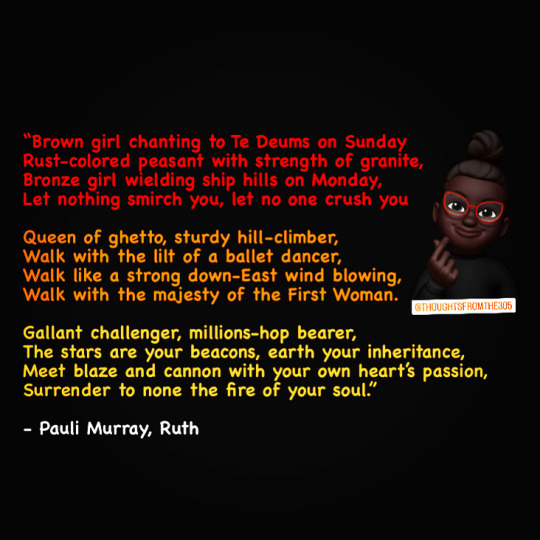
Ruth, by the late and very great Pauli Murray. Also note, that if Pauli lived in today’s society, they probably would have been labeled as non binary and or trans.
#Pauli Murray#Black Poetry#Always reading#Black Bibliophile#Bibliophile#Daughters of Africa#pride month
4 notes
·
View notes
Text
Review: Pauli Murray by Rosita Stevens-Holsey and Terry Catasús Jennings
Pauli Murray: The Life of a Pioneering Feminist and Civil Rights ActivistRosita Stevens-Holsey and Terry Catasús JenningsYellow JacketPublished February 8, 2022
Amazon | Bookshop | Goodreads
About Pauli Murray: The Life of a Pioneering Feminist and Civil Rights Activist
Pauli Murray was a trailblazer who spent her life fighting for civil rights and women’s rights. Writer, lawyer, activist,…

View On WordPress
3 notes
·
View notes
Text
Surrender to none the fire of your soul
- Pauli Murray
1 note
·
View note
Text
A poem by Pauli Murray
DARK TESTAMENT: VERSE 8
Hope is a crushed stalk
Between clenched fingers
Hope is a bird’s wing
Broken by a stone.
Hope is a word in a tuneless ditty —
A word whispered with the wind,
A dream of forty acres and a mule,
A cabin of one’s own and a moment to rest,
A name and place for one’s children
And children’s children at last . . .
Hope is a song in a weary throat.
Give me a song of hope
And a world where I can sing it.
Give me a song of faith
And a people to believe in it.
Give me a song of kindliness
And a country where I can live it.
Give me a song of hope and love
And a brown girl’s heart to hear it.
Dark Testament and Other Poems by Pauli Murray
2 notes
·
View notes
Text
currently very into both historical figure Pauli Murray and ace attorney, idk why but the gay lawyers have captured me
#Pauli Murray is very cool I have heard podcast and red articles and I just got a book#I’m so excited#read my biographys and play so much ace attorney#ace attorney#pauli murray
1 note
·
View note